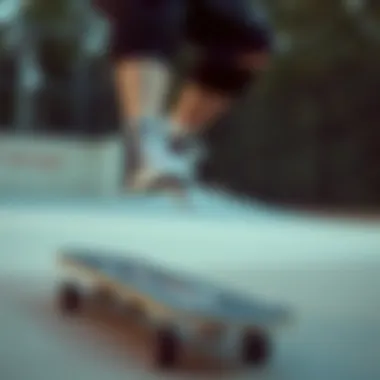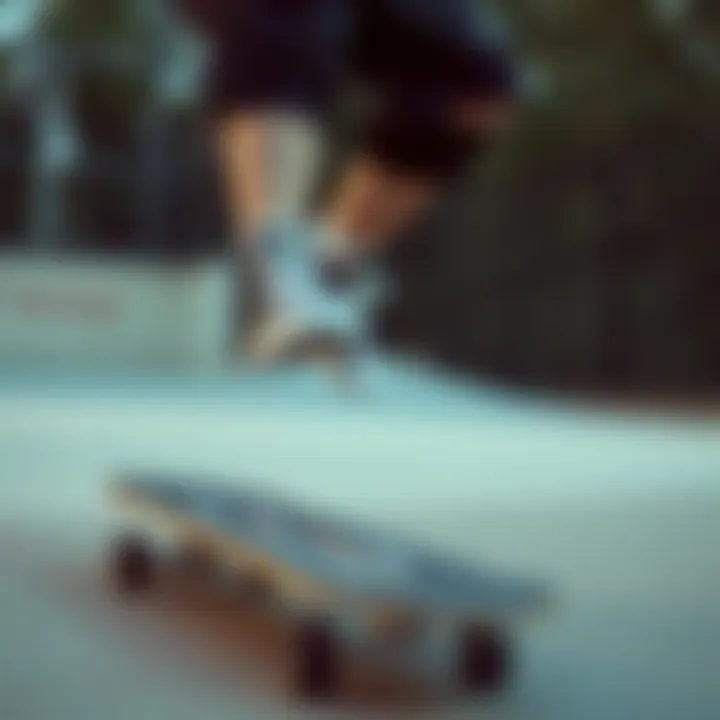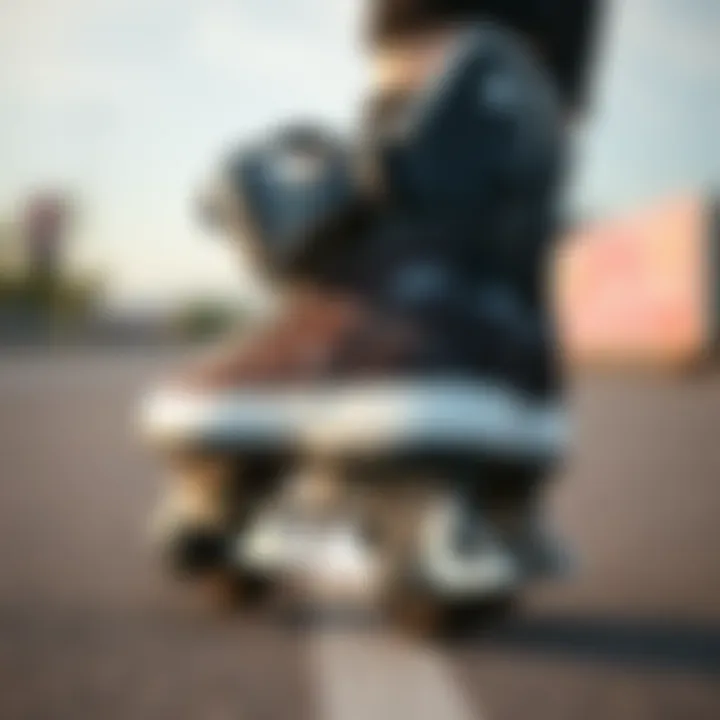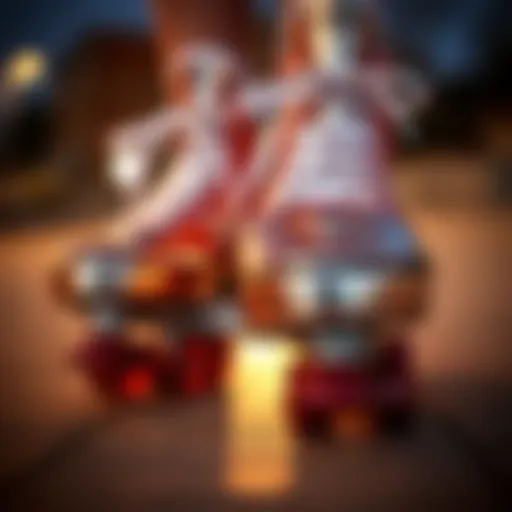A Closer Look at American Athletic Skates


Intro
Skateboarding stands as a significant cultural phenomenon in America, where the thrill of gliding on wheels intertwines with a rich artistic expression. At the heart of this sport lies the often-overlooked connection to athletic skates, which shape not only the performance of skaters but also their style and identity. American athletic skates have undergone a remarkable evolution, evolving from bulky, utilitarian designs to sleek, performance-driven models that cater to today's skateboarding enthusiasts. This article aims to unravel the various facets of American athletic skates, highlighting their importance in the skateboarding community, examining their advanced features, and understanding the user experience.
The journey begins with the essential gear that supports every skater. The right equipment does not just enhance performance—it also plays a crucial role in safety and personal expression. Let's delve into what skaters should consider when picking their equipment and maintaining it.
Essential Skateboarding Gear
Skateboarding isn’t just about flashy tricks and skill; it starts with having the right gear. Choosing the right skates can be a game changer, paving the way for both beginners and seasoned pros to develop their craft with confidence. Great American athletic skates strike a balance between safety, performance, and style.
Top Picks for Skateboards and Accessories
When it comes to American athletic skates, brands like Element, Birdhouse, and Zero lead the pack. Each offers distinctive features that ensure durability and performance. Here’s a brief look at some top options:
- Element Skateboards: Known for their sturdy designs, they come with a variety of deck sizes that cater to different riding styles. Their boards are often made from high-quality maple wood, which provides a solid balance of flexibility and strength.
- Birdhouse Skateboards: Founded by Tony Hawk, Birdhouse is loved for its visually appealing designs and reliable performance. They offer boards that are great for tricks, providing the right amount of pop needed for ollies and kickflips.
- Zero Skateboards: For the risk-takers, Zero blends punk aesthetics with high-end performance. Their boards are known for their durability, making them suitable for skaters who tend to take a few tumbles.
Accessories are equally important. Protective gear, such as helmets and knee pads, is essential. Don't skimp on quality—brands like Triple Eight and Pro-Tec provide top-notch safety equipment that feels comfortable and looks cool.
Maintenance Tips for Longevity
Just like any other equipment, your skates need some TLC to keep them in top shape. Here are some handy tips for proper maintenance:
- Regular Cleaning: Dirt and debris can wear down components over time. Wipe down the wheels and deck after each skating session to extend their life.
- Inspect Your Equipment: Before each session, give your skates a quick once-over. Check the wheels and bearings for wear and tear. Replace them promptly if they show signs of damage.
- Tighten Loose Parts: Skates take a beating, so bolts and screws can become loose over time. Make it a habit to tighten them to ensure everything is secure.
- Store Properly: When not in use, keep your skates in a cool, dry place to prevent mold or rust from forming on metal parts.
As skaters navigate through their journeys, familiarizing themselves with maintenance procedures ensures optimal performance and longevity of their gear. Knowing how to care for your athletic skates not only enhances your riding experience but also fosters a deeper connection with the equipment.
"The right gear can make all the difference between landing that trick or taking a spill. Take the time to invest in quality equipment and care for it properly."
In the world of skateboarding, where style is as important as skill, understanding your gear allows for both performance enhancement and personal expression. In the next sections, we delve deeper into specific skateboarding tricks and tutorials designed to elevate your skills, whether you're just getting started or you're an old hat in the park.
Intro to American Athletic Skates
The world of skateboarding carries a vibrant history woven with innovation, cultural shifts, and a community spirit unlike any other. At the heart of this culture are American athletic skates, essential tools that not only facilitate movement but also embody style, identity, and performance. It’s not just about gliding on wheels; it's about the choices made when selecting skates that resonate with personal taste and functional needs.
American athletic skates have exploded in popularity over the years, and for good reason. They represent a synthesis of engineering and artistry, ensuring that every skater achieves optimal performance on various terrains. These skates are designed to support agility, balance and speed, key traits demanded in skateboarding. The right pair of skates can not only enhance performance but also elevate a rider's confidence.
Another important element worth noting is how skates can foster connections among peers. The attachments that form around particular brands can become a part of skaters’ identities. Enthusiasts often discuss their preferred models in social settings or online forums, creating a culture of exchange and camaraderie. As such, understanding these skates dives deeper than technical aspects; it unlocks a more significant social narrative that reflects a lifestyle.
Furthermore, the advancements in skate technology continuously push boundaries. Each new design features improvements, often inspired by athlete feedback, technological research and changing skate styles. The evolution of these skates has led to materials that are lighter and more durable, providing a responsive experience, which can mean the difference between a successful trick or a fall. This development plays a crucial role in how skaters interact with their environment, influencing not just how they skate, but how they perceive it.
In essence, the exploration of American athletic skates is not merely about the mechanics of the skates themselves; it's a gateway to understanding a broader culture that celebrates freedom of expression and fearless creativity. By the end of this article, readers will have a comprehensive view of what these skates embody in both performance and lifestyle, leaving them better equipped to make informed decisions for their next ride. With that foundation laid, we can now delve into the rich history of American athletic skates.
History of American Athletic Skates
The history of American athletic skates serves as a vital aspect of understanding the broader context of skateboarding culture. By tracing the path of these skates from their infancy to their current status, we can appreciate the innovations that have shaped the sport and its community. Knowledge of this historical backdrop enhances the appreciation for modern designs and their functionalities.
Skates have not only evolved in terms of design and technology but also reflect the cultural shifts and social movements within the skating community. Each iteration tells a story about the wants, needs, and experiences of users over time, making it essential for skaters, influencers, retailers, and designers to understand this legacy.
Origins of Skate Technology
Skating as we know it today didn't spring from one single idea; instead, its origins lie in a series of inventions and adaptations. The genesis of skate technology can be traced back to the 18th century in Europe. The first recorded instance of a skate-like device was in 1760, created by a Belgian inventor named Johann Georg Ludwig Schneider. He devised a wooden shoe with metal blades—a far cry from what we see today. While these early prototypes didn’t strike much of a chord with the public, they set the stage for future innovations.
In the late 19th century, the interest in roller skating surged, particularly on the streets of America. This surge led to the development of the first practical roller skates, which featured four wheels in a rectangular configuration—quite primitive by modern standards but groundbreaking back then. They were a hit at roller rinks and in local competitions.
As we move forward into the 20th century, skateboarding emerged as a form of expression and a sport in itself. The first skateboards were simply wooden boards with roller skate wheels attached. They were a makeshift solution, yet they lived up to the creative potential of the young riders who fashioned them. Without a structured skate technology, kids began to improvise tricks, fuelling a burgeoning culture around skateboarding.
Evolution Through the Decades
The evolution of American athletic skates is not merely a tale of changing designs; it’s an ongoing conversation between skaters and the tools they use. The 1970s marked a pivotal transformation in skate design, driven by the need for speed and stability. Companies like Powell Peralta and Vision Street Wear stepped up to the plate, introducing wider and stronger decks along with better trucks and wheels. The introduction of urethane wheels revolutionized ride smoothness and grip, creating a noticeable shift in performance.
In the 1980s and 1990s, tricks became more complex, prompting further innovations. The rise of brands such as Vans and Etnies brought foot support, grip, and style into sharper focus. They began offering shoes that catered specifically to the complexities of skateboarding, balancing comfort and performance. This decade reflected the heart of skate culture, where skaters defined their identities through their gear.
Fast forward to the 2000s and beyond, skateboarding saw a blend of technology and artistry. Skates today use advanced materials that enhance durability and performance, making them withstand the rigors of daily use.
Aspects like lightweight frameworks and specialized bearings have emerged as important considerations. Moreover, we are now witnessing a surge in sustainable practices within skate manufacturing, addressing both performance and environmental responsibility.
"The history of skates is a mirror reflecting the changing attitudes, needs, and technologies of society."
Understanding this evolution not only allows for a comprehensive perspective on current trends but also opens the door to anticipation of future developments in skate technology. The foundational shifts reveal a blend of ingenuity and rebellious spirit, characteristics that continue to thrive in the skateboarding community today.
Key Features of American Athletic Skates
Understanding the key features of American athletic skates is essential for anyone serious about skateboarding. These aspects not only define the skates themselves but also contribute significantly to the rider's overall experience. From the choice of materials to design specifics like boot construction, wheel composition, and bearing types, every detail plays a crucial role in performance and style. Selecting the right skate features means understanding how they affect usability, comfort, and functionality.


Materials Used in Production
When considering athletic skates, the materials used in their construction matter a great deal. Manufacturers focus on durability and performance, making use of advanced composites and high-grade plastics. Commonly used materials like nylon and aluminum provide strength without overly increasing weight, which is vital for mobility and agility on the board.
Benefits of Material Choice:
- Durability: High-quality materials ensure that the skates withstand daily use and varied conditions.
- Weight: Lightweight materials allow skaters to maneuver easily.
- Comfort: A soft inner lining, often made from breathable fabric, helps to enhance comfort.
However, the trade-off can come in the form of price. Higher-quality materials often mean higher costs, forcing skaters to weigh their budget against performance needs.
Design Elements
The design elements of skates encompass many factors that impact the rider’s performance, including boot construction, wheel composition, and bearing types.
Boot Construction
Boot construction is a foundational aspect of any skate. A well-constructed boot offers support and stability. Skates with a hard shell provide superior ankle protection, whereas softer boots allow for more flexibility.
Key Characteristics of Boot Construction:
- Ankle Support: Harder boots promote stability during tricks and jumps.
- Flexibility: Softer boots encourage a wider range of motion for fluid movements.
One unique feature in some high-end models is adjustable boot stiffness. This allows users to customize their skate for various skating styles or personal comfort levels.
Advantages:
- Adds personal touch to skater’s experience.
- Facilitates transition between different skate styles.
Wheel Composition
The choice of wheels significantly affects performance and ride quality. Common materials include urethane, which provides grip and durability. The hardness and diameter of the wheels can dramatically alter the skating experience.
Key Characteristic of Wheel Composition:
- Duro Rating: A higher duro rating results in harder wheels, which are better suited for smooth surfaces.
- Diameter: Larger wheels help in overcoming obstacles while smaller ones allow for increased maneuverability.
Unique Feature: Some skaters prefer wheels that light up, not primarily for aesthetic reasons but also for increased visibility in low-light environments.
Advantages:
- Allows customization based on terrain and skating style.
- Enhances visibility for safety.
Bearing Types
Bearings are the unsung heroes of skates, ensuring a smooth glide. Generally rated by the ABEC (Annular Bearing Engineering Committee) scale, the quality of bearings can make or break a ride. Higher ABEC ratings translate to tighter tolerances, which often result in faster speeds.
Key Characteristic of Bearing Types:
- Material: Most bearings are made of stainless steel for longevity, while ceramic bearings offer a lighter alternative that performs better under heat.
- Sealing: Different bearing seals offer distinct advantages in terms of maintenance and speed.
Unique Feature: The emergence of hybrid bearings blends materials to combine traits of both aluminum and ceramic, proposing a balance between weight and speed.
Advantages:
- Provides skaters with a variety of choices based on usage such as speed or durability.
- Hybrid options can be more versatile.
In summary, the key features of American athletic skates provide a framework not just for functionality but also for personal expression in the skating community. Understanding these elements is paramount to making informed purchases that suit individual skating styles and preferences. By considering materials, design, and technology, enthusiasts can choose skates that enhance their riding experience.
The Influence of Technology on Performance
When it comes to American athletic skates, the influence of technology shapes not just how skaters glide on their boards but also how they embrace the culture itself. Technology allows for groundbreaking modifications in design, materials, and performance features, fundamentally changing the way athletes interact with their gear. Modern skates offer a plethora of enhancements, providing users with unparalleled advantages in maneuverability, speed, and overall control. In a game where every millisecond counts, understanding the technological interplay in performance can offer a competitive edge.
Innovative Skate Technologies
Over the past few decades, skate manufacturers have pushed the envelope by integrating various ingenious technologies into their products. These innovations range from enhanced materials to sophisticated engineering techniques.
Materials Science Advances
The primary shift has been seen in material selection. High-tech polymers and carbon fiber have made their way into skate construction, resulting in lighter yet sturdier skates. For instance, consider the use of EVA foam for cushioning. This material isn’t just about comfort; its shock-absorbent properties can make a discernible difference during high-impact maneuvers.
Ergonomic Design
Another aspect is the attention to ergonomic design, which ensures that the skates mold to the anatomy of the foot for increased comfort and precision. Skate designs that feature improved ankle support allow skaters to perform more complex tricks with confidence, reducing the risk of injury.
Intelligent Features


Moreover, several models now integrate smart technology - think skates equipped with sensors that provide feedback on everything from balance to pressure distribution. This can help skaters refine their skills and pinpoint weaknesses in their technique.
How Technology Enhances User Experience
Technology does not solely enhance performance metrics; it also alters the overall experience for the skater. The blend of innovation and user-centric design leads to a more rounded skating adventure, where safety and enjoyment become paramount.
Safety Enhancements
To start, many contemporary skates come with features that prioritize safety without sacrificing performance. For example, advanced grip technology on wheels can provide better traction on various surfaces, making skaters less likely to slip or lose control.
Customization and Personalization
Another layer of user experience is customization. Many brands allow skaters to personalize their setups, from wheel hardness to boot color, catering not just to functional preferences but also to individual style. This creates a connection between the skater and their equipment, transforming the experience from a mere athletic pursuit to a form of self-expression.
"The integration of technology in American athletic skates is not just about performance; it's about how skaters connect with their journey on the board."
Enhanced Community Engagement
With advancements in technology, many brands are tapping into social media and online platforms. Skaters can now share their experiences, tricks, and tips more readily than before. This helps build communities and amplify the skate culture, allowing for shared knowledge and support.
As skating evolves, the future seems boundless. Whether it's pushing the boundaries of innovation or enhancing the thrill of riding, technology continues to be a cornerstone of the American skate experience.
Athlete Endorsements and Market Trends
Athlete endorsements play a crucial role in shaping the landscape of American athletic skates. The connection between a skater and their gear can often define an athlete’s personal brand, influencing both their performance and the choices consumers make. When a prominent figure in the sport showcases a specific skate brand, it resonates deeply with fans and aspiring skaters alike. Often, these endorsements serve as a stamp of approval, suggesting that if these athletes trust their gear, so can their followers. This fosters a unique sense of loyalty and might even dictate trends in skate design and functionality.
Influencer Impact on Skate Preferences
In the world of skateboarding, influencers hold substantial sway over consumer preferences. Their reach on platforms like Instagram, TikTok, and YouTube can dramatically alter how certain skate models are perceived. When a beloved skater highlights the benefits of using a specific pair of skates—perhaps showcasing tricks or stunts—it's not just marketing; it feels like an invitation to join a community.
For example, take Nyjah Huston, known not just for his talent but also for his highly engaged social media presence. When he promotes his skate line, countless fans not only take heed but often replicate his style, shifting towards brands he endorses. This ripple effect amplifies brand visibility and demand, making it paramount for manufacturers to align with skaters who resonate with their target audience's values and lifestyles.
"When a skater you look up to endorses a product, it’s like they’re giving you the green light to go for it. You feel part of their journey."
Emerging Trends in Skate Culture
As we look closer at the current skate culture, it's evident that technology and environmental awareness are driving new trends. There's a notable shift towards sustainable practices, reflecting broader concerns about environmental impact. Many brands are beginning to incorporate recycled materials into their skate production, catering to a demographics that values sustainability. This aligns with a growing trend among skaters who prioritize eco-friendly options without sacrificing performance.
Additionally, the rise of urban skating has shifted preferences. Cities with vibrant skate parks and street spots have become breeding grounds for innovation in skate styles. Skate designs are evolving to accommodate these environments; softer wheels for rough terrain and tighter turning capabilities for street skating a evident adaptations.
These trends not only influence what skaters are looking for in their gear but also what companies are producing. The alignment of athlete endorsements with current trends can be critical, as they navigate public perception and consumer interest.
Maintenance and Care for Skates
The essence of skateboarding extends beyond tricks and techniques—it lies significantly in how well a skater maintains their gear. Proper maintenance and care for skates are essential not only for performance but for safety as well. Any seasoned skateboarder can tell you that regular upkeep can prevent costly repairs and enhance the lifespan of the skates. When skates are cared for, skaters can enjoy smoother rides and heightened control, making for a better overall experience on the board.
Monitoring your skates involves understanding various components, recognizing wear and tear, and addressing issues before they escalate. Those diligent in maintenance often find it influences their skating confidence; when the gear feels dependable, they can focus on pushing their limits!
Routine Checks and Repairs
Regularly checking your skates is akin to giving your car a tune-up. You wouldn’t hit the road without assessing the tires, would you? Likewise, skaters need to inspect their equipment frequently to keep everything in top-notch condition. Here are a few key areas to pay attention to during routine checks:
- Wheels: Examine for flat spots or cracks. The wheels should roll smoothly; if they wobble, it’s time for a change.
- Bearings: If you hear grinding noises or notice friction when spinning the wheels, this indicates the bearings may need cleaning or replacing. Regular lubrication can fend off rust and grime, prolonging their life.
- Boot Condition: Check for any visible damage to the boot, such as cracks or loose seams. A well-fitting boot is critical for both performance and support.
Even small issues, if left unattended, can morph into significant problems. A swift quality check every few sessions can save you from unwanted surprises mid-skate. As the saying goes, "A stitch in time saves nine!"
Storage and Durability Factors
The manner in which skates are stored can significantly affect their durability. After a long day at the skatepark, tossing them into the trunk of your car might be tempting, but this can lead to damage over time. Here are several tips for proper storage:
- Cool and Dry Place: Store your skates in a cool, dry area. Moisture can promote rust on metals, destabilizing both bearings and screws.
- Use Skate Bags: Invest in a quality skate bag with padding. This not only protects them during transport but keeps dirt off, which is crucial for the wheels and bearings.
- Avoid Weight: Don’t pile heavy objects on top of your skates. Pressure can warp the boots and deteriorate performance.
In essence, investing time in both the maintenance and storage of your skates translates into a consistent and enjoyable skate experience. By adhering to these simple, actionable steps, skaters can realize the full potential their equipment has to offer, paving the way for not just longevity, but also enhanced performance.
"Taking care of your gear is like securing the foundation of a house; it keeps everything standing strong."
For more insights on skateboard maintenance and care, check out resources like Reddit or articles on Britannica for tips from fellow enthusiasts.
Comparative Analysis of Popular Models
In the world of skating, choosing the right pair of skates is akin to selecting the perfect brush for an artist or the right instrument for a musician. A comparative analysis of popular models serves not only as a guide but as a roadmap for skaters of all skill levels. It helps in understanding how different features, prices, and brand reputations align with personal skating styles and needs. This deep dive into varied skate models offers critical insights that can affect performance, comfort, and ultimately, enjoyment while skating.
Budget vs. High-End Options


When it comes to skates, the price range can be as wide as the ocean. On one hand, budget models typically sound appealing, catching the eye with a lower price tag. However, they often come with trade-offs in materials and longevity. The fit may not be ideal, and weight can be heavier, potentially hampering performance. Beginners, especially, might find these options tempting—a way to get into skating without breaking the bank.
On the flip side, high-end skates can feel like the Rolls Royce of the skating world. Models from brands like Roces, Bont, and Mongoose often employ lightweight materials, precision engineering, and advanced technologies that enhance every glide and turn. Many skaters who invest in these options appreciate the improved comfort, responsiveness, and durability. Nevertheless, a hefty price tag can leave some skaters feeling squeezed.
The decision often comes down to individual needs. A skater who enjoys casual outings may see value in budget options, while more serious skateboarders or competitive skaters might find that the investment in high-end models pays off in performance and satisfaction over time.
Performance Ratings of Leading Brands
Performance ratings give skaters a glimpse into how well different brands hold up under the pressures of actual skating. Brands such as Element, Blind, and Santa Cruz become household names in part because of their consistency in producing high-performing skates. These models often undergo rigorous testing and evaluation, which is why many skaters rely on performance ratings when making a choice.
From comfort levels to maneuverability, performance can vary dramatically:
- Flexibility: A model that boasts good flexibility can enhance tricks, allowing for a full range of motion.
- Grip and Stability: Certain brands excel in creating wheels with high traction, ensuring that skaters can maintain stability during complex maneuvers.
- Durability: Resilient materials in the boot and chassis can determine how long the skates last, often highlighting the importance of quality over price.
Many online platforms and skate communities like Reddit and user review sections at SkateWarehouse provide valuable insights and discussions on specific models, helping buyers gauge satisfaction from those who have already hit the pavement or rink.
Skateboarding Destinations and their Influence
Skateboarding destinations play a pivotal role in shaping not just the culture of skating but also the identity of skaters themselves. When we talk about a skateboarding destination, we’re not just referring to any patch of concrete or wooden ramps; we’re discussing iconic locations that have become synonymous with skateboarding culture, breeding grounds for creativity and style. These places offer not just physical space for skating but also a sense of community and history that resonates deeply with enthusiasts.
Iconic Skate Spots
When you think of skate spots that have carved a place in history, a few locations shout louder than others. Places like the Embarcadero in San Francisco or Venice Beach in California have hosted countless video parts and served as the backdrop for skater legends to hone their craft. The natural architecture of these areas provides unique challenges and opportunities that contribute to individual styles. These spots are where tricks are documented, legendary sessions reported, and friendships forged.
Skate spots often have their stories baked into the pavement. Did you know that the famous wall ride at the Brooklyn Banks has been a classic for decades but is now more inaccessible due to construction? Such knowledge adds layers to the experience for skaters—when they skate a historic spot, they’re tapping into a well of shared memory intertwined with community’s grit and tenacity. Beyond just skate tricks, there is an understanding of the socio-political influences behind these places and how they change or evolve.
"The spot is part of the skate itself; it gives rise to the tricks, the videos, the lifestyle."
Regional Preferences in Skating Styles
Geography significantly influences skating styles, reflecting the cultural and environmental elements of different regions. For instance, skaters on the West Coast often lean towards a more fluid style, deeply influenced by the wider-open spaces and smooth terrains. Here, bowl riding and transition skating often take precedence, giving rise to the heavy influence of vert skaters.
In contrast, the streets of New York City lead to a markedly different approach. With more confined spaces and harsher urban landscapes, skaters often gravitate towards technical street skating that emphasizes obstacles. Manual pads, ledges, and stairs become the canvases for creativity and innovation. This divergence in styles not only showcases individuality but also fosters a healthy competition among skaters, pushing each other to redefine limits.
- West Coast: Fluid, transition-focused
- East Coast: Technical, street-centric
- Midwest: A blend of both styles and a burgeoning indie skate scene.
Understanding regional influences not only helps skaters appreciate their roots but also encourages dialogues on how various cultures interact within the larger skateboarding community.
As an informative endeavor, the significance of skateboarding destinations cannot be overstated. They serve as pillars of inspiration, pushing boundaries and enriching the culture across generations.
Future Directions in Skate Design
In the world of skateboarding, the design of American athletic skates is perpetually evolving. The need for skaters to remain agile, durable, and eco-conscious drives innovations in this space. This section will discuss future directions set to redefine skate design, focusing on two specific areas: sustainability and anticipated innovations.
Sustainability in Skate Materials
The shift towards sustainability is more than just a trend; it’s a commitment to protecting the environment for future generations. The skating industry has begun to recognize that the materials used in skate production play a significant role in their ecological footprint.
- Biodegradable Materials: There are emerging efforts to incorporate biodegradable materials in skate production. This means that once a skate reaches the end of its life, it can naturally decompose without contributing to landfill waste.
- Recycled Plastics and Metals: Some brands are exploring the use of recycled plastics and metals to create skate components, reducing the demand for virgin materials and lessening environmental impacts.
- Sustainable Manufacturing Processes: Manufacturers are also reconsidering their production methods. By adopting energy-efficient techniques and minimizing waste during the manufacturing process, companies can further mitigate the environmental consequences of skate production.
"A skate that cares for the planet is a skate that captures the hearts of mindful consumers."
Anticipated Innovations
Innovation is the lifeblood of skate culture. As technology advances, skaters can look forward to exciting developments in skate design that will transform their experience on the board. Some anticipated innovations include:
- Smart Skates: Imagine skates equipped with sensors that track performance metrics in real-time, such as speed, balance, and even tricks completed. This technology could provide skaters with valuable feedback to help them improve.
- Adaptive Design: Future skates may integrate adaptive features that allow users to customize their fit and support on the fly, promoting higher levels of comfort and performance.
- 3D Printing: The rise of 3D printing could allow custom skate designs tailored to individual anatomy, leading to improved comfort and performance. Users could potentially personalize their gear right from their homes, changing the game of skateboarding gear altogether.
- Enhanced Grip Technology: Innovations in grip might also be on the horizon. Look out for specialized rubber compounds that provide better traction on various surfaces without compromising aesthetics.
Ultimately, the future of skate design hinges not only on technological advancements but also on our responsibility to the planet. As we embrace these emerging ideas, the intersection of sustainability and innovation can lead the American athletic skate industry into a new era.
Closure: The Lifeline of American Athletic Skates
As we reach the end of our journey exploring American athletic skates, it becomes evident that this topic weaves through various aspects of skateboarding culture, design innovation, and user engagement. It’s clear that skates are not just pieces of equipment; they are pivotal in defining the skating experience itself.
Importance of American Athletic Skates
American athletic skates embody more than just physical design elements such as wheels and bearings. They represent a fusion of art and technology that has evolved over decades. One can argue that these skates are a lifeline for both casual enthusiasts and professional athletes alike. Without a proper skate, how can one truly hone their skills or even enjoy a ride? The material selection, boot construction, and technological enhancements all contribute to the overall performance, ease of use, and durability.
Moreover, skater endorsements play a significant role in shaping what makes a skate brand revered. Athletes endorse certain models that resonate with their styles and preferences, leading to a ripple effect among fans and budding skaters. This isn’t just about marketing, but rather a reflection of what it means to be part of a vibrant community.
"Skating is more than just a sport; it's an embodiment of freedom, expressions, and connections among skaters."
Benefits of Understanding Skates
By understanding the nuances of American athletic skates, one can make informed decisions about their gear. Knowledge regarding maintenance practices can prolong the life of skates, enhancing their performance and ensuring functionality during critical moments. For retailers, understanding consumer preferences and trends engenders better inventory choices. For designers, grasping the evolving tastes of skaters allows for conscious innovation that can lead to groundbreaking designs.
Considerations Going Forward
It's essential to consider sustainability in skate production. The future of this industry might hinge on the choices made today regarding material sourcing and environmental impacts. Innovations in skate design not only promise performance enhancements but also signal a shift towards a more conscious approach to manufacturing. Brands that embrace sustainability could elevate their status in the competitive skate market.
In summary, American athletic skates are a multidimensional topic filled with layers of significance. They shape the experience of skating, influence trends, and reflect cultural sentiments. As technology advances and as we witness a shift towards sustainable practices, skates will continue to evolve, remaining a crucial element of the skateboarding lifestyle.



